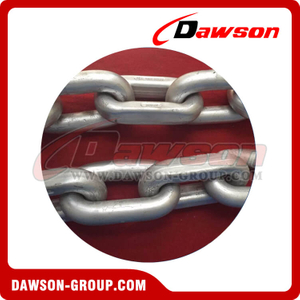Application of Lifting Chain Slings
- Dawson Group Ltd. - China Manufacturer, Supplier, Factory


Lifting chain is designed for use with hoists, cranes, winches, and other material handling equipment. It is also used in rigging slings and for lashing. There are two standard grades for lifting chain: grade 80 lifting chain and grade 100 lifting chain. Other grades of lifting chain may also be available from some suppliers.

Grade 80 lifting chain is made from alloy steel and is specifically designed for overhead lifting applications. This grade of lifting chain has a good strength-to-weight ratio and excellent durability.
Grade 100 lifting chain is also made of alloy steel, but is hardened and tempered for superior durability and fatigue resistance. Most Grade 100 lifting chain is made of Herc-Alloy 800, a heat-treated alloy with very high strength. Although many types of chain fittings are available, Grade 80 fittings should not be used with Grade 100 chain.
Selecting lifting chain requires an analysis of performance specifications. Lifting chain size is measured in inches (in.) or millimeters (mm). Common sizes include 7/32 in. (5.5 mm), 9/32 in. (7.0 mm), 5/16 (8.0 mm), 3/8 (10.0 mm), 1/2 in. (13.0 mm), 5/8 in. (16.00 mm), 3/4 in. (20.0 mm), 7/8 in. (26 mm), and 1 1/4 in. (32.0 mm). Nominal dimensions include inside length and inside width. Other important considerations for choosing lifting chain are the approximate number of links per foot (ft.) and the approximate weight (lbs.) per 100 ft.
When working with lifting chain, working load limit and rated capacity vary with the angle of use and the number of lifting chain used in a sling. For example, a single 5.5 mm lifting chain may be rated for 2100 lbs. at 90 degrees. A double 5.5 mm lifting chain may be rated for 60, 45, or 30 degree use with working loads of 3600, 3000, and 2100 lbs. respectively.
Lifting chain should meet requirements from organizations such as the U.S. Occupational Safety and Health Administration (OSHA), the American Society for Testing Materials (ASTM), and the International Standards Organization (ISO). Working load limits for Grade 80 and Grade 100 lifting chain are based on a 4 to 1 design factor from ISO.
Lifting chain safety
Optimal performance requires the understanding of guidelines and adherence to safety regulations
Overhead lifting chain slings are useful tools for various types of overhead lifting operations and are frequently used for material handling in construction and manufacturing. Following industry guidelines is key to optimizing the use of these slings in a safe and effective manner.
Why is safety such an important issue for overhead lifting? Lifting or applying loads in any direction is incredibly dangerous work. Failure of any component or link in the chain can result in catastrophic failure. Heavy loads can be dropped, causing massive damage to equipment and facilities as well as serious injury or even death to workers. The operation, care, and maintenance of chain slings are important factors in the long-term, safe use of these devices and ensure the safety of anyone working with or near an overhead lifting device.
Chain sling or sling component use is governed by the U.S. Department of Labor OSHA regulations. In particular, Section 1910.184 governs the operation and usage of alloy steel chain slings and sling components. A chain sling or chain product must always be operated in strict accordance with federal OSHA regulations. Any user or operator of a chain sling device should be completely familiar with these OSHA requirements.
SELECTION OF CHAIN SLINGS
Chain slings come in a variety of lengths and combinations of hooks and components, depending on the lifting application. The chain manufacturers have specified a variety of chain testing and safety standards in American Society of Mechanical Engineers (ASME) B30.9, ASTM-A906, and the National Association of Chain Manufacturers. Any chain sling used for lifting must have suitable characteristics for the type of load hitch and environment used and must be in accordance with ASME B30.9, Sections 9-1.5 and 9-1.8.
The working load limit (WLL), or rated capacity of chains and slings, is determined by the “grade” of the chain and its components. For overhead lifting, only high-grade alloy steel chains and components may be used. These devices must meet a variety of strict quality standards such as minimum breaking strength, fatigue testing, and heat resistance.
The most commonly used chains for overhead lifting are rated at Grade 80, however, the industry is moving to the safer and stronger Grade 100 and Grade 120 chains. The WLL and lifting capacity increases as the grade increases. For example, a 3/8 inch Grade 80 chain has a WLLof 7100 pounds, a 3/8 inch Grade 100 chain has a WLL of 8800 pounds, and a 3/8 inch Grade 120 chain has a WLLof 10,600 pounds—50% higher than Grade 80. For safety reasons, each chain and sling is rated with a 4:1 design factor. The 3/8 inch Grade 80 chain with a WLLof 7100 pounds is pull tested to 14,200 pounds and has a minimum breaking load of 28,400 pounds.
Every chain or chain sling is only as strong as its weakest link, so it is very important that every component of the sling meets WLL. All chains and components must be marked by the manufacturer with a grade from which the load rating can be determined. It is important to note that a number of factors such as lifting at an angle, wrapping the chain around a load, or extreme temperature reduce the WLL of the sling substantially. These factors must be considered when determining what type of sling is necessary to lift a load.
READ THE LABEL
Each chain sling is supplied with a certificate and an identification tag. The identification tag includes the name of the manufacturer, the grade of chain, the nominal chain size, the number of chain legs, the length (reach) of the sling, the rated loads for the sling assembly, and the angle upon which the rating is based. Always look for proper and clear identification, especially the WLL. Some manufacturers also provide sling warning kits that can be attached to a chain sling. The owner and user of the chain sling are responsible for maintaining and repairing the sling and its identification tags.
Keep in mind these usage and training safety rules:
Only trained individuals are allowed to use chains slings as specified by OSHA 1926.20 (a)(4)
Operate a chain sling in strict accordance with OSHA 1910.184 and ASME B30.9
No portion of the body shall be placed between the sling and the load or the sling and the crane or hoisting hook
In no circumstance shall personnel stand or pass under a suspended load
Slings may be shortened or lengthened only by methods approved by the manufacturer or a qualified person
Sharp edges in contact with the sling should be padded to protect the sling
Slings shall not be constricted, bunched, or pinched by the load, hook, or any fitting.
The identification tag includes vital information, including the grade of chain, the nominal chain size, the number of chain legs, and the rated loads for the sling assembly. Always look for proper and clear identification, especially the working load limit.
WORKING LOAD LIMITS OF SLINGS
Observing the WLL is a critical safety aspect in all overhead lifting operations. Exceeding the WLL of a chain sling can cause chain failure and, consequently serious injury. To avoid hazards, consider:
Always accurately determine the load, force, or weight that is to be lifted or carried with the chain sling.
Do not attempt to use a chain sling without complete and accurate knowledge of the force or weight carried by each part of the sling. Even if the sling as a whole may be within the WLL, non-uniform center of gravity locations can result in unbalanced loading conditions.
Include all applicable capacity reduction factors when determining the WLL. These factors can substantially reduce the ability of the chain sling to carry a load safely.
Do not use slings at angles of less than 30 degrees, as measured from the horizontal plane.
Chemically active environments can reduce the strength and WLL of an alloy steel chain sling, or even make the sling unusable.
Shock or impact loading can substantially increase the chain sling's force to a level well beyond the WLL.
Consult an engineer for approval prior to performing a lifting application if the load's weight or chain sling's WLL is unknown.
INSPECTION AND MAINTENANCE
In order to ensure a safe operation of chain slings, inspection and maintenance are very important. Excessive wear of any single component can result in a failure of the sling and serious injury.
In order to avoid this hazard, keep the following points in mind:
Inspect slings in accordance with federal OSHAregulations and ASME B30.9 standards
Perform and record frequent and periodic inspections of chain slings
Prior to use, order an inspection of all new, altered, modified, or repaired chain slings to verify compliance with ASME B30.9
Visually inspect chain slings for damage before use each day
Proper measurements using precision instruments of each link and each component should be performed to provide a benchmark for allowable tolerances
Written records containing the most recent periodic inspection should be maintained by the owner or user of the chain sling.
Safety checklist
Proper safety practices should be followed, including never walking under a suspended load.
Ensure all slings have identification and warning tags
Maintain records, including test certifications, drawings, instructions, warnings, and maintenance records of each chain sling
Ensure that personnel performing overhead lifting applications are properly trained
Ensure that slings are inspected before use
Establish an inspection and maintenance plan in accordance with ASME
Perform sizing and load calculations to ensure loads remain within working load limits
Review and approve lifting applications to ensure loads remain within working load limits and that lifts remain stable
Familiarize yourself with federal OSHA requirements and ASME B30.9 standards.
Choosing the right chain Determine the maximum load to be lifted
Determine the type of slings needed (single, double, etc.)
Estimate the proper angle between the leg of the sling and the load
Select the proper fittings (hooks, master rings, etc.)
Determine the overall reach (measured from the bearing point on the master link to bearing point of fitting)
Choose a chain size that meets your required work load, angles, and reduction factor
Choose grade, type, and finish of steel that meets your requirements.
We can supply the following products:
G100 Alloy Chain, G80 Alloy Chain, G70 Chain & Fittings, Welded Link Chain, Weldless Link Chain, Mining Chain, Fishing Chain,
Stainless Steel Link Chain, Skidder Chain, Snow Chain, Animal Chain, Hatch Cover Chain
If you need more information, please contact us: info@dawson-group.com.
 English
English















